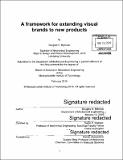| dc.contributor.advisor | David R. Wallace. | en_US |
| dc.contributor.author | Björkdal, Douglas H | en_US |
| dc.contributor.other | Massachusetts Institute of Technology. Department of Mechanical Engineering. | en_US |
| dc.date.accessioned | 2016-07-01T18:42:46Z | |
| dc.date.available | 2016-07-01T18:42:46Z | |
| dc.date.copyright | 2016 | en_US |
| dc.date.issued | 2016 | en_US |
| dc.identifier.uri | http://hdl.handle.net/1721.1/103466 | |
| dc.description | Thesis: S.M., Massachusetts Institute of Technology, Department of Mechanical Engineering, 2016. | en_US |
| dc.description | Cataloged from PDF version of thesis. | en_US |
| dc.description | Includes bibliographical references (pages 89-94). | en_US |
| dc.description.abstract | Visual design has become an increasingly important product differentiation tool for companies. By deploying a consistent visual design language that communicates brand-specific values, a company can foster recognition for its brand as a whole. When a brand seeks to launch a new product, it can take advantage of its established brand recognition, by extending its visual language to the new product. In doing so, the brand increases the new product's ability to be recognized. Supportive branding tools for industrial designers are lacking, yet strategic decisions related to visual design have become increasingly important. The objective of this thesis was to investigate how designers may extend a brand's visual design language to new products in practice. A framework was derived based on established branding theory and on design research related to visual recognition. The aim was to derive a framework that could support designers in strategic decisions, while also leaving room for designers to express their individual creativity within a viable frame of reference. An experiment was conducted to assess the framework's performance and designers' attitudes towards it. In addition, designers' own practical approaches to the task were explored. An expert panel was utilized to evaluate designers' product drafts. The results indicate that designers, while applying the framework, designed products that communicated the target brands' visual design language more clearly than without the framework, whereas no significant difference in the concepts' creativity levels were found. Perceived advantages associated with the framework were usually linked to its structure and helpfulness in determining brands' visual strategies. In order to strengthen the findings of this study, future research should explore the effectiveness of the proposed framework with larger sample sizes and additional means of evaluation. The framework may prove especially useful in educational settings, fostering designers' ability to think about visual design in a strategic manner. As such, future experiments may be conducted at institutions offering educational programs within the field of industrial design. | en_US |
| dc.description.statementofresponsibility | by Douglas H. Björkdal. | en_US |
| dc.format.extent | 111 pages | en_US |
| dc.language.iso | eng | en_US |
| dc.publisher | Massachusetts Institute of Technology | en_US |
| dc.rights | M.I.T. theses are protected by copyright. They may be viewed from this source for any purpose, but reproduction or distribution in any format is prohibited without written permission. See provided URL for inquiries about permission. | en_US |
| dc.rights.uri | http://dspace.mit.edu/handle/1721.1/7582 | en_US |
| dc.subject | Mechanical Engineering. | en_US |
| dc.title | A framework for extending visual brands to new products | en_US |
| dc.type | Thesis | en_US |
| dc.description.degree | S.M. | en_US |
| dc.contributor.department | Massachusetts Institute of Technology. Department of Mechanical Engineering | |
| dc.identifier.oclc | 952320972 | en_US |
